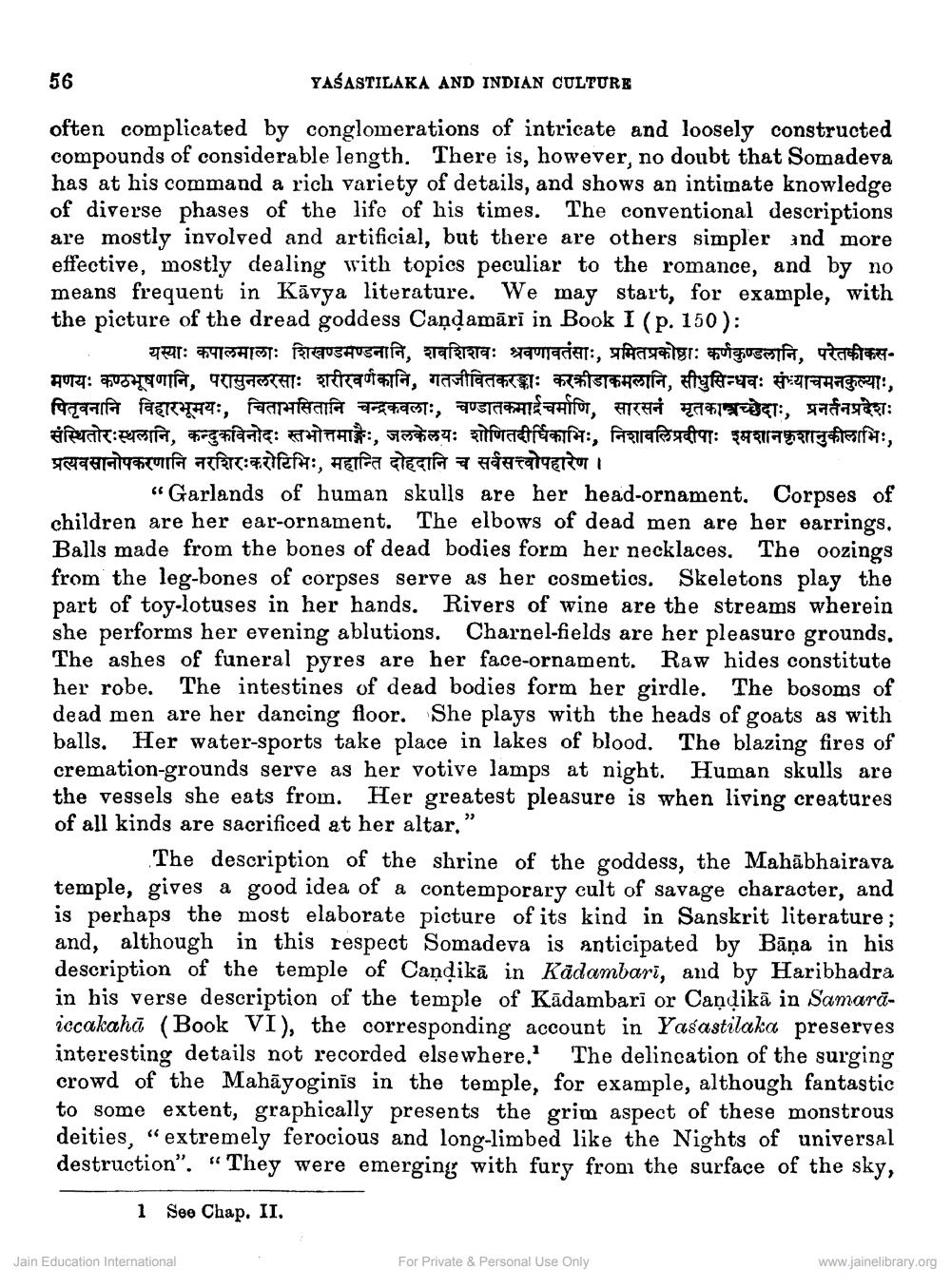________________
56
YAŠASTILAKA AND INDIAN CULTURE
often complicated by conglomerations of intricate and loosely constructed compounds of considerable length. There is, however, no doubt that Somadeva has at his command a rich variety of details, and shows an intimate knowledge of diverse phases of the life of his times. The conventional descriptions are mostly involved and artificial, but there are others simpler and more effective, mostly dealing with topics peculiar to the romance, and by no means frequent in Kāvya literature. We may start, for example, with the picture of the dread goddess Caņdamāri in Book I (p. 150):
यस्याः कपालमालाः शिखण्डमण्डनानि, शवशिशवः श्रवणावतंसाः, प्रमितप्रकोष्ठाः कर्णकुण्डलानि, परेतकीकस. मणयः कण्ठभूषणानि, परासुनलरसाः शरीरवर्णकानि, गतजीवितकरङ्काः करक्रीडाकमलानि, सीधुसिन्धवः संध्याचमनकुल्याः, पितृवनानि विहारभूमयः, चिताभसितानि चन्द्रकवलाः, चण्डातकमाईचर्माणि, सारसनं मृतकात्रच्छेदाः, प्रनर्तनप्रदेशः संस्थितोरःस्थलानि, कन्दुकविनोदः स्तभोत्तमाङ्गैः, जलकेलयः शोणितदीर्घिकाभिः, निशावलिप्रदीपाः श्मशानकृशानुकीलाभिः, प्रत्यवसानोपकरणानि नरशिरःकरोटिभिः, महान्ति दोहदानि च सर्वसत्त्वोपहारेण ।
“Garlands of human skulls are her head-ornament. Corpses of children are her ear-ornament. The elbows of dead men are her earrings, Balls made from the bones of dead bodies form her necklaces. The oozings from the leg-bones of corpses serve as her cosmetics. Skeletons play the part of toy-lotuses in her hands. Rivers of wine are the streams wherein she performs her evening ablutions. Charnel-fields are her pleasure grounds. The ashes of funeral pyres are her face-ornament. Raw hides constitute her robe. The intestines of dead bodies form her girdle. The bosoms of dead men are her dancing floor. She plays with the heads of goats as with balls. Her water-sports take place in lakes of blood. The blazing fires of cremation-grounds serve as her votive lamps at night. Human skulls are the vessels she eats from. Her greatest pleasure is when living creatures of all kinds are sacrificed at her altar.”
The description of the shrine of the goddess, the Mahābhairava temple, gives a good idea of a contemporary cult of savage character, and is perhaps the most elaborate picture of its kind in Sanskrit literature; and, although in this respect Somadeva is anticipated by Bāņa in his description of the temple of Candikā in Kādambari, and by Haribhadra in his verse description of the temple of Kādambarī or Candikā in Samarāiccakahā (Book VI), the corresponding account in Yasastilaka preserves interesting details not recorded elsewhere. The delineation of the surging crowd of the Mahāyoginis in the temple, for example, although fantastic to some extent, graphically presents the grim aspect of these monstrous deities, "extremely ferocious and long-limbed like the Nights of universal destruction”. “They were emerging with fury from the surface of the sky,
1 See Chap. II.
Jain Education International
For Private & Personal Use Only
www.jainelibrary.org




